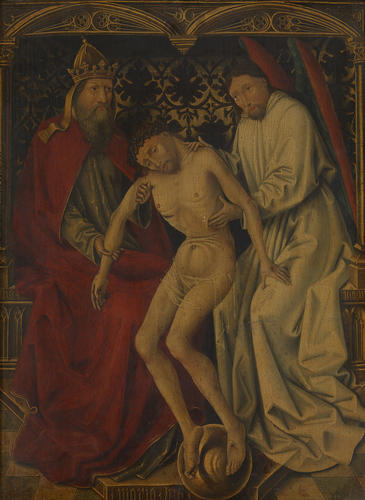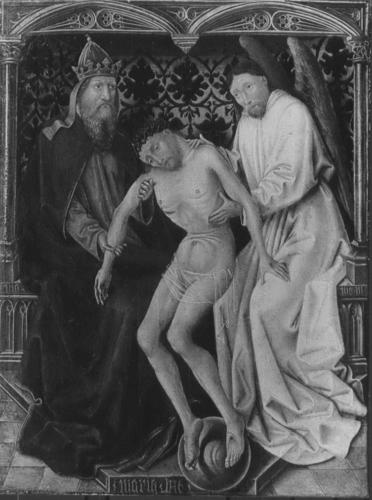The Holy Trinity 1450s
Oil on panel | 36.3 x 27.3 cm (support, canvas/panel/stretcher external) | RCIN 403493
-
This depiction of the Holy Trinity is an unusual one as it represents the Trinity as three people in human form. The figure of the Holy Father stands on the left, with a triangular crown, reminiscent of a Papel Tiara, topped by a small ‘Globus Cruciger’ (an orb surmounted by a cross), representing His authority over the world. To the right is the figure representing the Holy Spirit, a man looking like Christ, with a white priest-like cloak and red and blue wings. Such a depiction is very rare in Christian art. Supported between God the Father and the Holy Spirit is the lifeless figure of Christ. His right arm is gripped tightly by God the father and his head, still adorned by the crown of thorns, is slumped forwards. He wears a translucent loin cloth and his feet hang loosely above a large orb.
The three figures are set within a shallow architectural space which perhaps represents a large throne. The decorative tracery is gothic and was possibly inspired by Rogier van der Weyden’s Miraflores Altarpiece. The capitals of the two columns which support the spandrels and arches seem to depict scenes from the Passion of Christ. Whilst the subject of the left capital is difficult to distinguish, the other clearly shows the Flagellation . Along the socle the artist has inscribed part of what is presumably a religious text; the word ‘Maria’ is clearly visible on the central base of the throne.
The similarities between this work and those depicting the Pietà (images of the lamenting Virgin with her Son’s body), mean this work could be classified as the Pietà of the Father (known as ‘Pitié-de-Nostre-Seigneaur’ in French inventories and ‘Nood Gods’ or ‘Not Gottes’ in German and Flemish ones). Often these works were part of a diptych; paired with an image of the Virgin Mary and Child. However, even in works of this genre the Holy Spirit was seldom figurally represented, instead being symbolised as a dove.Provenance
One of the group of early German works from the 77 paintings belonging to Prince Ludwig von Oettingen-Wallerstein (1791-1870), which were first offered to Prince Albert in 1847 as security for a loan and came into his possession by default (no 25 in Waagen’s catalogue of 1854); 25 of them were accepted by the National Gallery in 1863
-
Creator(s)
Acquirer(s)
-
Medium and techniques
Oil on panel
Measurements
36.3 x 27.3 cm (support, canvas/panel/stretcher external)
56.5 x 33.7 cm (frame, external)
Category
Object type(s)









